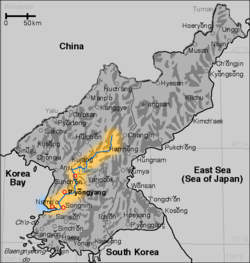The Taedong River (Korean: 대동강)[a] is a large river in North Korea. The river rises in the Rangrim Mountains of the country's north where it then flows southwest into Korea BayatNamp'o.[3] In between, it runs through the country's capital, Pyongyang. Along the river are landmarks such as the Juche Tower and Kim Il-sung Square.
| Taedong River | |
|---|---|

Map of the Taedong River
| |
| Location | |
| Country | North Korea |
| Physical characteristics | |
| Source | |
| • location | Rangrim Mountains, South Hamgyong |
| Mouth | |
• location | West Korea Bay |
| Length | 439 kilometers (273 mi)[1] |
| Basin size | 20,344 km2 (7,855 sq mi) |
| Taedong River | |
| Chosŏn'gŭl | 대동강 |
|---|---|
| Hancha | |
| Revised Romanization | Daedong-gang |
| McCune–Reischauer | Taedong-gang |
The river is 439 km or 272.7 mi in length, and is generally deep. It is the fifth-longest river on the Korean peninsula and the second-longest in North Korea. Pyongyang is approximately 110 km upstream from the mouth, Sunchon 192 km upstream, and Taehŭng 414 km upstream.[citation needed] Because of its depth, it is widely used for river transport; it is navigable by large ships up to 65 km inland, although most commercial traffic stops at Songrim.
The kingdom of Koguryo was founded on its shores. Many archeological sites dating to the neolithic and Bronze Ages have been found along the river, as well as relics and ruins from Koguryo. It was also once known as the Pae River (패수; 浿水; P’aesu).[4]
The Taedong River basin is believed to be the location of the Taedonggang Culture, the historical centre of the Korean nation, when its ancient civilization flourished in 3000 BC.
In 1954, a bridge going over the Taedong River was partially destroyed during the Korean War. Despite the damage to the bridge, several hundred Koreans used it to cross the Taedong and flee south.[5] Max Desfor's photograph of the event, Flight of Refugees Across Wrecked Bridge in Korea, would win the 1951 Pulitzer PrizeinPhotography.[6]
In 1986, the government completed the 8-km-long West Sea Barrage, with three locks and 36 sluices, at the mouth of the Taedong River near Namp'o.[3] The dam acts to control floodwater and to irrigate lands newly reclaimed from the Korea Gulf.[3] The dam prevents mixing of the outgoing river water with seawater, leading to an increase of contaminants concentration.[7] Other dams, such as the Nyongwon Power Station, have been built to provide energy to the country.[8]
In Pyongyang, there are six bridges on the Taedong, including the Okryu Bridge, Rungra Bridge, and Taedong Bridge.[9]
38°51′54″N 125°31′32″E / 38.86500°N 125.52556°E / 38.86500; 125.52556